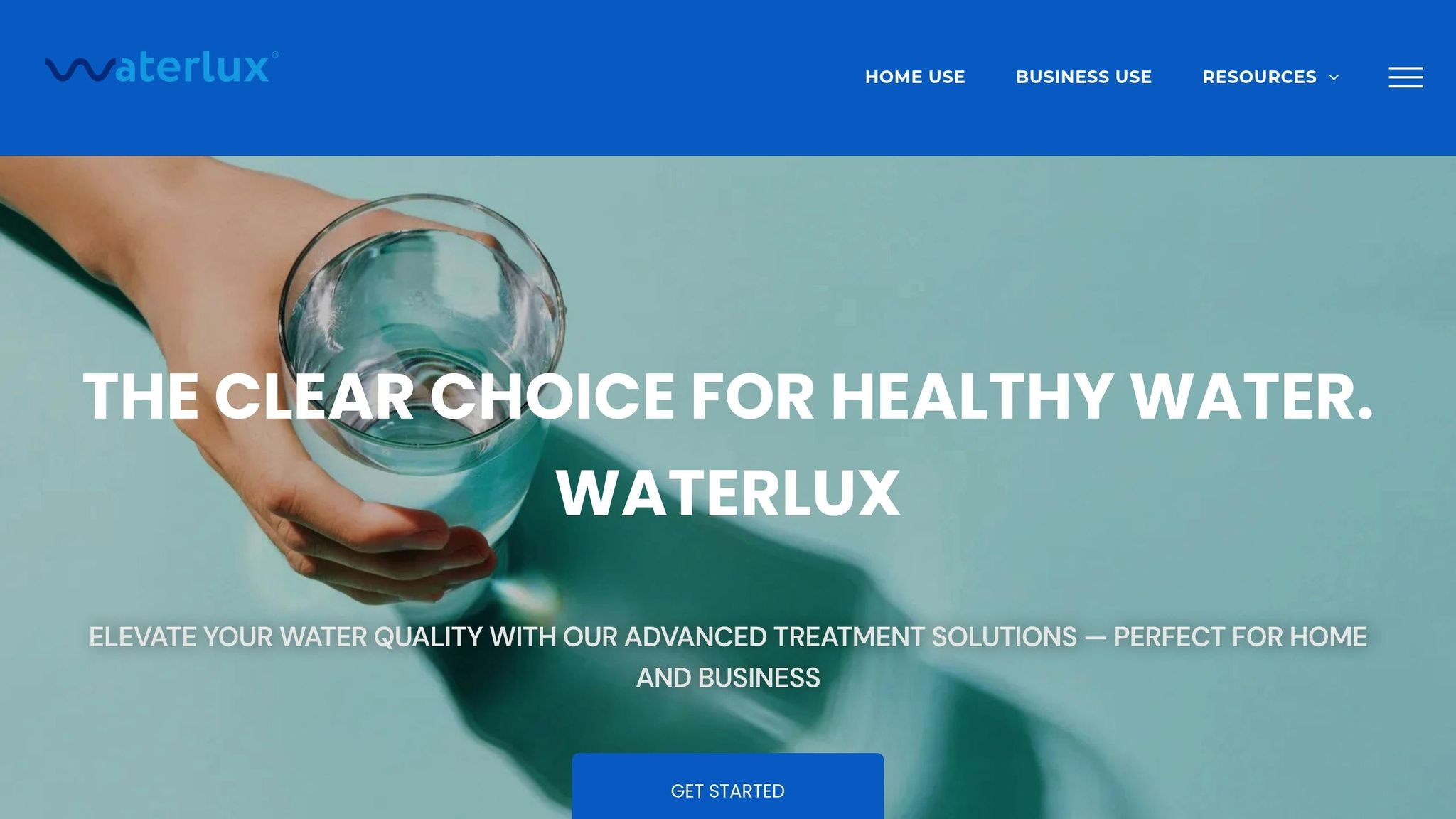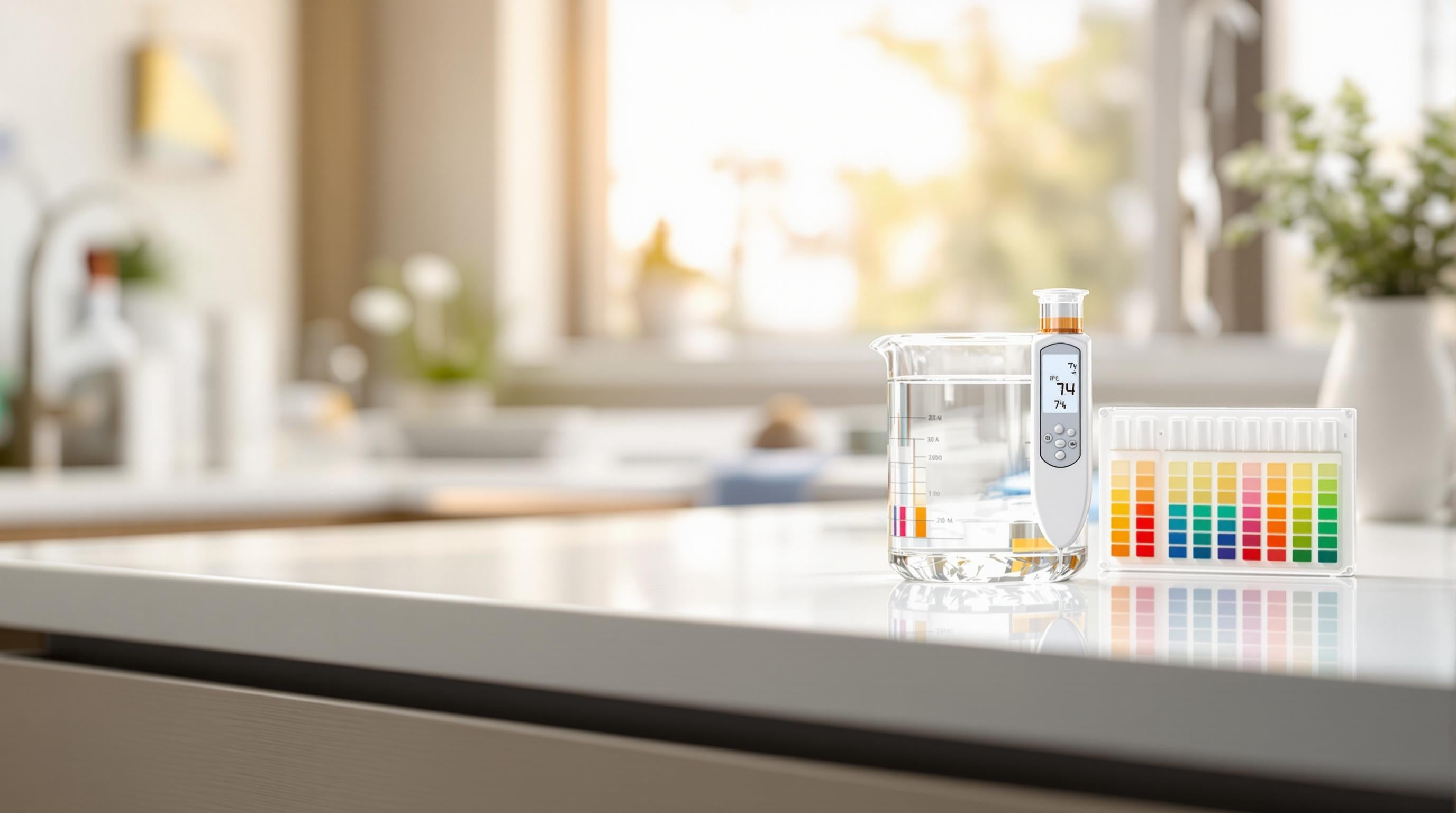pH is a measure of how acidic or alkaline water is, ranging from 0 (acidic) to 14 (alkaline). A neutral pH is 7. For safe and good-tasting water, the EPA recommends a pH range of 6.5 to 8.5. Here's why it matters:
- Low pH (<6.5): Can corrode pipes, release harmful metals like lead, and leave a metallic taste.
- High pH (>8.5): Can cause scale buildup, reduce the effectiveness of disinfectants, and leave a bitter taste.
How to Test and Adjust pH:
-
Test Methods:
- Digital pH Meters (precise but need calibration).
- Test Strips (affordable but less accurate).
- Liquid Test Kits (color-based, requires good lighting).
-
Adjusting pH:
- For acidic water: Use neutralizing filters or add minerals.
- For alkaline water: Install acid injection systems or reverse osmosis.
Regular testing ensures water safety, protects plumbing, and keeps treatment systems efficient.
pH Measurement Tools and Methods
Testing Equipment Options
Here are three common ways to measure pH at home:
- Digital pH Meters: These devices deliver precise readings and adjust for temperature automatically. Just remember to calibrate them regularly for the best results.
- pH Test Strips: These are a budget-friendly, disposable option. They rely on color changes to give you an approximate pH level.
- Liquid Test Kits: These kits use reagents that change color to indicate pH. Good lighting is key to interpreting the results correctly.
Tips for Accurate Testing
To ensure your pH readings are reliable, follow these steps:
- Sample Collection: Use a clean plastic container, rinse it with the sample water first, then collect the sample and test it at room temperature.
- Equipment Maintenance: Keep your tools in a cool, dry place and calibrate them according to the manufacturer’s instructions.
- Testing Practices: Allow the sample to settle before testing, rinse probes between uses, and take duplicate readings to confirm consistency.
These steps will help you get dependable pH readings, which are essential for managing water quality effectively.
For home water testing, WATERLUX suggests using a combination of digital pH meters for precision and pH test strips for convenience. This approach helps maintain steady water quality and ensures your water treatment system works as it should.
pH and Water Quality Standards
Safety Standards and Home Systems
The EPA recommends a pH range of 6.5–8.5 to protect both your health and your plumbing. Water with a low pH can corrode pipes, potentially releasing harmful metals into your water and damaging household appliances. On the other hand, water with a high pH can cause scale buildup, which restricts water flow and reduces the efficiency of your plumbing system.
Water Treatment System Performance
pH levels play a big role in how well water treatment systems work. They affect filter media performance, the lifespan of membranes, and the success of chemical treatments. If the water is too acidic or too alkaline, filters may not work as intended, membranes may wear out faster, and overall treatment efficiency can drop.
WATERLUX whole-house systems are designed to handle pH fluctuations effectively. To keep your system running smoothly, check your water's pH monthly or after any major changes to your water source. Knowing these standards is key to successfully testing and adjusting pH levels at home.
Home Water pH Testing Guide
How to Test Your Water's pH
-
Collect Your Water Sample
- Run cold water for 2–3 minutes to flush the pipes.
- Fill a clean glass container with about 8 ounces of water.
- Test the sample right away to ensure accurate results.
-
Set Up Your Testing Tools
- Calibrate your testing equipment using standard buffer solutions (pH 4.0, 7.0, and 10.0). This step is crucial for accurate readings.
-
Conduct the Test
- Using Test Strips: Dip the strip into the water for 15–30 seconds.
- Using a Digital Meter: Place the probe into the sample and wait until the reading stabilizes.
- Record the results and repeat if necessary for consistency.
If your results fall outside the 6.5–8.5 range, you’ll need to adjust the pH.
Adjusting Your Water's pH Levels
If your water's pH is outside the ideal 6.5–8.5 range, here’s how to fix it:
For Acidic Water (pH below 6.5):
- Install a neutralizing filter with materials like calcite or magnesium oxide.
- Use a water ionization system to raise the pH.
- Consider adding a reverse osmosis system with a remineralization feature.
For Alkaline Water (pH above 8.5):
- Install an acid injection system for precise adjustments.
- Use a reverse osmosis system to balance the pH while filtering out impurities.
- Have a professional add food-grade acid neutralizers for safe correction.
WATERLUX pH Management Systems

WATERLUX offers solutions to handle pH imbalances effectively:
Advanced Alkaline Systems
- The WATERLUX Alkaline Water Ionizer Machine KYK55000 ($1,299.00) uses ionization technology for accurate pH control.
- The Alkaline Reverse Osmosis System with Electric Pump ensures stable pH levels while removing contaminants.
Whole House Solutions
WATERLUX's home systems combine pH management with powerful filtration, including:
- Automatic pH monitoring and adjustments.
- A multi-stage filtration process for cleaner water.
- Compatibility with both municipal and well water sources.
For best results, test your water monthly to keep your system running smoothly.
sbb-itb-38ad72f
pH Testing Problems and Solutions
Common pH Testing Errors
Getting accurate pH test results depends on using the right techniques. Here are some common mistakes and how to avoid them:
- Temperature Effects: Always test samples at a steady room temperature (around 68°F) to ensure consistent results.
- Cross-Contamination: Rinse your equipment with distilled water and dry it with lint-free paper towels after each use. This prevents contamination from previous samples.
- Storage Issues: Improper storage can make test strips and digital meters unreliable. Keep them in their original containers, stored in a cool, dry place, away from sunlight and chemical vapors.
- Calibration: Digital meters need regular calibration with fresh, room-temperature buffer solutions. Make sure probes are cleaned thoroughly before calibrating.
Purified water adds another layer of complexity when it comes to pH testing.
Testing Purified Water
Purified water, like reverse osmosis (RO) or distilled water, has very low mineral content. This makes testing trickier, but here’s how to handle it:
- Reverse Osmosis Water: RO water can give unstable readings due to its minimal mineral content. Let the sample sit briefly to equilibrate with the air, use digital meters made for low-mineral samples, and take multiple readings to calculate an average.
- Distilled Water: The low ionic strength of distilled water often causes erratic readings. For better accuracy, use specialized low-ionic strength electrodes designed for this purpose.
Testing Tips:
- Skip standard test strips for purified water - they’re not reliable.
- Keep sample containers sealed to avoid CO₂ absorption, which can alter the pH.
- Test immediately after collecting the sample for the most accurate results.
- For the best precision, use a bench-top pH meter or specialized electrodes for low-ionic strength samples.
If you're working with WATERLUX systems, regular maintenance and careful testing are crucial, especially when dealing with purified water.
Using a pH Meter - Everything You Need to Know About pH
Key Points Review
Getting pH levels right is crucial for both water safety and the efficiency of your system. Here's what you need to know:
- pH Testing: Precise testing ensures your water stays balanced and safe to use.
- Protecting Your System: Proper pH levels help safeguard plumbing, preventing issues like corrosion or scaling.
- Efficient Treatment: WATERLUX whole-house systems are designed to handle pH effectively while providing thorough water treatment.
These principles are the foundation of managing pH in your home effectively.

